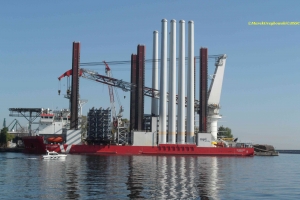Offshore wind energy in crisis. Management and Business Plans for revision

 By Marek Grzybowski
By Marek Grzybowski
Offshore wind energy is in deep water and facing unprecedented difficulties in the face of rising costs. Leading operators in this monopolized market are announcing unprecedented budget gaps after three quarters. There have already been voices about the need for governments to save companies and pressure to drain the pockets of industrial and retail consumers.
More attention will need to be paid to classes on business plans and company and project management in conditions of risk, including macroeconomic ones, at offshore postgraduate and MBA studies. Building and harmonizing supply chains should be practiced, because “just-in-time” and extensive outsourcing have not worked. Macroeconomics classes and more knowledge about economic cycles and the effects of market monopolization will also be useful.
Companies investing in offshore wind farms have shown their cards
It was already known in spring that something disturbing was happening in the industry. In the summer, everyone tried to wait out the heat. Reuters analysts tried to explain why the offshore wind industry went into turbulence in September this year. The signal from the British market was very clear.
“The UK’s latest auction of subsidies for new renewable energy projects failed to attract bidders from the offshore wind industry, raising concerns among developers and environmental groups that the country may struggle to meet its climate targets,” said Reuters’ Nina Chestney and Susanna Twidale.
The companies discovered the cards in September and October this year. BP’s head of renewable energy said in early November this year that the US offshore wind industry is “fundamentally broken,” and BP and its partner Equinor (EQNR.OL) are exploring the possibility of implementing massive projects worth $840 million off the coast. New York – reports CNN.
A week earlier, BP wrote down $540 million and Equinor took a $300 million write-down on the Empire and Beacon offshore wind projects with a total capacity of 3.3 gigawatts. BP paid Equinor $1.1 billion in 2020 for a 50% stake in the venture.
Summer Solstice
Already in the summer, Ørsted shares fell by 25% after problems in the US offshore market were revealed. The assets of the world’s largest offshore wind company lost almost 7 billion pounds in value because of a possible write-off of 1.8 billion pounds, Rob Davies from the Guardian informed the British.
Orsted Americas CEO David Hardy said the company was “extremely disappointed” to have halted its development in the United States.
“Macroeconomic factors have changed dramatically in the short term, and high inflation, rising interest rates and supply chain bottlenecks are impacting our long-term capital investments,” Hardy explains in a statement, telling Americans: “As a result, we have no choice but to stop work over Ocean Wind 1 and Ocean Wind 2.”
In response, New Jersey Governor Phil Murphy, a key promoter of the projects, sharply criticized the company’s decision.
“Ørsted’s decision today to abandon its commitments to New Jersey is outrageous and undermines the company’s credibility and competence,” Murphy said in a statement, according to CNN. “I have directed my administration to review all agreements and legal remedies and take all necessary steps to ensure that Orsted fully and immediately honors its obligations,” Governor Murphy said emphatically.
American winds in the OWF production and logistics
Industry experts told CNN that one reason the U.S. industry has been so slow to grow — especially compared to offshore wind giants like Europe and China — is that U.S. developers are essentially building it from scratch. Therefore, harmonizing supply chains, a shortage of ships and rising interest rates have made the construction of the first large offshore wind projects in the US very difficult.
It’s not just investors who have financial problems. They also affected producers. Siemens Energy, one of the largest producers of wind turbines in the world, has asked the German government for financial assistance in the face of expected losses of EUR 4.5 billion this year.
Meanwhile, General Electric, manufacturer of the 14 MW Haliade-X wind turbines, announced last month that its offshore wind energy division expects a loss of $1 billion in 2023 and the same in 2024, Bloomberg reported. It should be noted that General Electric Co’s (NYSE:GE) renewable energy production generated a loss of $2.24 billion in 2022, while a loss of $795 million was recorded in 2021.
First the project – then the fight for tax breaks
The governor of New Jersey should have become concerned already in August, when the investor announced that there may be delays in the investment and that it may cost DKK 5 billion (approximately USD 650 million). Then the company announced that the Ocean Wind 1 project would be put into operation a year later than planned, in 2026.
The investor failed in talks with American representatives of the administration regarding obtaining tax breaks for both projects. Over the summer, Ørsted sought to obtain at least 40% relief from the U.S. government on all of its projects.
The company said talks were “not progressing as we had previously expected” and that it was struggling to cross the 30% threshold. This meant that Ørsted would have to make a one-off payment of up to 6 billion kroner.
Persistently high interest rates would cost the company an additional CZK 5 billion if the investment was initiated and implemented. Such expenses would have to be incurred if rates do not fall by the end of the third quarter, Ørsted announced a month before deciding to withdraw from the project.
Strategic desire
This review of economic results and comparison of activities in a stable economy, both producers and investors, are exposed to high risk, and business failures generate billions of losses. It turned out that economic winds were mainly to blame for business failures.
Companies have done a lot to reduce the unit production and service costs associated with the installation costs of offshore wind farms. The information shows that risk analysis and forecasting of macroeconomic phenomena failed in business projects. International organizations and governments have failed by designing programs that lack long-term projections of expenses and risks related to strategic turbulence.
In the case of supply chains and production organization, the harmonization of activities, well described and effectively implemented over 100 years ago by the Polish management classic Karol Adamiecki, has failed. Harmonization programs integrated with real CAPEX and OPEX would avoid many surprises.
Cardinal mistakes were made in planning and production. The principles of good work and comprehensive application of the features of a good plan, described in detail many years ago by Tadeusz Kotarbiński, were violated. Then such drastic failures would most likely not have occurred.
Some explanations of failures give the impression that the basis for creating some strategic projects, both on the part of governments and companies, is desire, not strategic analysis and a solid business plan.
